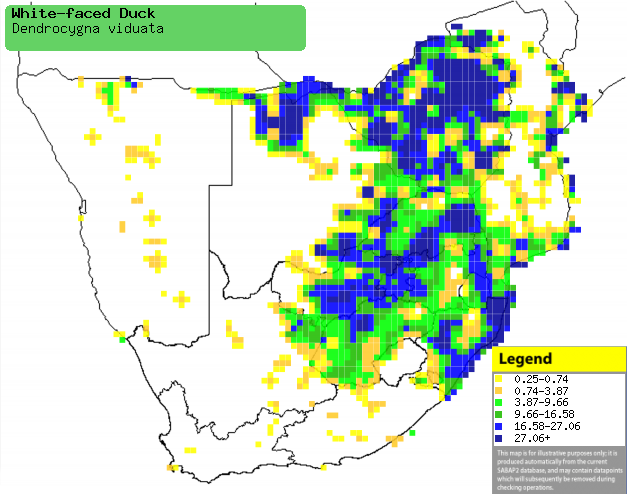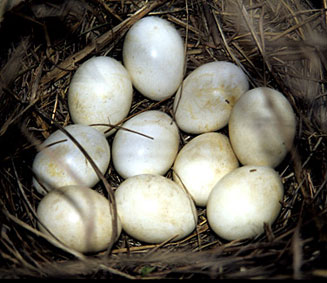|
Dendrocygna viduata (White-faced
duck)
Nonnetjie-eend [Afrikaans]; Idada (generic term for duck)
[Xhosa]; iVevenyane [Zulu]; Ehilili [Kwangali]; Letata (generic term for duck)
[South Sotho]; Dada, Sekwe (both are generic names for duck or goose) [Shona];
Lidada lemfula [Swazi]; Xiyahkokeni [Tsonga]; Sehudi (generic term for duck)
[Tswana]; Witwangfluiteend [Dutch]; Dendrocygne veuf [French]; Witwenente
[German]; Pato-assobiador-de-faces-brancas [Portuguese]
Life
> Eukaryotes >
Opisthokonta
> Metazoa (animals) >
Bilateria >
Deuterostomia > Chordata >
Craniata > Vertebrata (vertebrates) > Gnathostomata (jawed
vertebrates) > Teleostomi (teleost fish) > Osteichthyes (bony fish) > Class:
Sarcopterygii (lobe-finned
fish) > Stegocephalia (terrestrial
vertebrates) > Tetrapoda
(four-legged vertebrates) > Reptiliomorpha > Amniota >
Reptilia (reptiles) >
Romeriida > Diapsida > Archosauromorpha > Archosauria >
Dinosauria
(dinosaurs) > Saurischia > Theropoda (bipedal predatory dinosaurs) >
Coelurosauria > Maniraptora > Aves
(birds) > Order: Anseriformes >
Family: Dendrocygnidae
This long-necked, dark brown duck with a white face and
greyish-black bill has a wide distribution ranging from tropical America to
Africa, Madagascar and the Comoro Islands. It is found mainly on inland waters
in savanna and grassland regions, and in southern Africa is considered one of
the most common ducks in these regions. It feeds both in the water (mainly on
aquatic vegetation and seeds), and on land (mainly on grass seeds, including
seeds from cultivated crops such as maize and sorghum). Small amounts of
invertebrates are also eaten (molluscs and insects).
Distribution and habitat
Widespread: found in tropical America, sub-Saharan Africa,
Madagascar and the Comoro Islands. Within sub-Saharan Africa, found in most
regions except dense rainforest and arid areas. In southern Africa, it is found
mainly in the Free State, North-West Province, Gauteng, Limpopo, Mpumalanga, KwaZulu-Natal,
Swaziland, Mozambique, Zimbabwe, and south-western and northern Botswana. Found mainly
on inland waters in savanna and grassland regions.
|
 |
|
Distribution of White-faced duck in southern Africa,
based on statistical smoothing of the records from first SA Bird Atlas
Project (©
Animal Demography unit, University of
Cape Town; smoothing by Birgit Erni and Francesca Little). Colours range
from dark blue (most common) through to yellow (least common).
See here for the latest distribution
from the SABAP2. |
Predators and parasites
- Predators
- Parasites
- pathogens
- Clostridium botulinum Type C (avian
botulism).
- ectoparasites
- Phthiraptera (lice)
- Holomenopon dendrocygni
- Acidoproctus rostratus
- Trinoton aculeatum
- Acarina (mites)
- Hirudinea (leeches)
- Theromyzon cooperi: known to cause
paralysis and death.
Food
- Mainly plant matter (> 99% of diet)
- When feeding in the water eats:
- young shoots of:
- Potamogeton crispus (Pondweed)
- leaves and stems of:
- seeds of the following aquatic plants:
- Scirpus
- Nymphaea (water lily)
- Persicaria lapathifolia
- Heliotropium indicum (String of
stars) nutlets
- tubers of:
- algae:
- When feeding on land eats:
- seeds/fruits of:
- Zea mays (Maize)
- Echinochloa pyramidalis (Antelope
grass)
- Eriochloa (Harpoon grass)
- Leersia (swamp cut grass)
- Panicum coloratum (White buffalo
grass)
- Panicum schinzii (Land grass)
- Dactyloctenium aegyptium (Crowfoot)
- Paspalum scorbiculatum (Creeping
paspalum)
- Dichrostachys cinerea (Sickle bush)
- Persicaria serrulata (knotweed
species)
- Persicaria lapathifolia (Spotted
knotweed)
- Polygonum aviculare (knotweed
species)
- Sesamum triphylum (Sesame)
- Hibiscus (hibiscus)
- Atriplex (salt bush)
- Ambrosia artemisifolia (Ragweed)
- Ceratophyllum demersum
- Sorghum (sorghum)
- Amaranthus (pigweed)
- Sida rhombifolia (Spiderleg)
- Small amount of animal food eaten (< 1%) although in
half-grown ducklings up to 7% animal material has been recorded in their
diet. Recorded animals eaten include:
- molluscs
- Melanoides tuberculata
- Gastropoda
- unidentified species
- pulmonate snail (Thiaridae)
- Pelecypoda
- Concostraca
- insects
Breeding
- Nest consists of a scrape in the ground, lined with
grass and other vegetable matter, and hidden among long grass, sedges or
other vegetation. Nest is usually situated near the water's edge but can be
up to 3 km away!
- Egg-laying season is mainly in spring, summer and autumn (September to May),
peaking in summer.
 |
|
|
White-faced duck nest with eggs, Sericea farm,
South Africa. [photo
Warwick Tarboton ©] |
|
- The female lays 4-13 eggs (clutches of up to 16 eggs
probably the result of more than one female laying), one egg being laid per
day. Incubation probably starts after the clutch has been completed, lasts
26-30 days, and is undertaken by both sexes (but mainly the male).
- Young are diving for food by 14 days, are able to fly
by 63 days, and have adult plumage by about 180 days. The parents accompany
the young until even after they have started flying. They are especially
protective of the young in their early development and keep them well hidden
and attract predators away from the young by using the broken-wing act.
Threats
Not threatened and in fact its distribution and density
has increased as a result of the creation of artificial water bodies (e.g. farm
dams) and the growing of grain crops, which they feed on.
Links
References
-
Hockey PAR, Dean WRJ and Ryan PG (eds) 2005. Roberts
- Birds of southern Africa, VIIth ed. The Trustees of the John Voelcker
Bird Book Fund, Cape Town.
|
